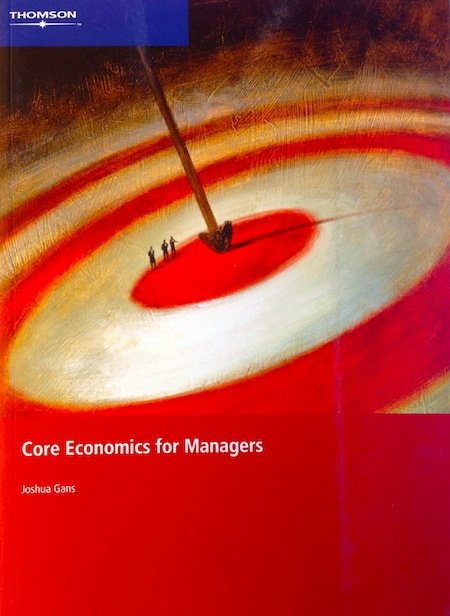In this engaging text, Joshua Gans turns economic teaching on its head. Specifically aimed at the management or MBA student, Core Economics for Managers covers the essentials but does so in ways that build on and reinforce the student's work experiences.
Beginning with the tools of decision-making, this book does not shy away from the complexities of managerial decisions but embraces them to consider both uncertainty and strategic interaction in a readily accessible way. This allows the student to move with ease to consider the principles of negotiated exchange and how prices are formed when parties interact face to face rather than anonymously in markets. This provides a natural way of talking about competition and the gains from cooperation.
The traditional topics of economics and competitive strategy can then be introduced by considering pricing; that is, how a firm chooses its price, how a firm can innovate in pricing, how prices are constrained by competition and how prices can act as signals for investment. Finally, with all of these tools in hand, the student can seamlessly move on to the topics of contracting, outsourcing, the provision of incentives and the building of relationships.
No other single book covers this multitude of topics in such an accessible way. Gone are unnecessary jargon from economics and strategy. All that remains is the core. And that core can be taken with the student back into their studies and commercial life.
Published in 2005 by Cengage, Australia.
For some online materials including demos and exercises please click here.
TABLE OF CONTENTS
1. Introduction: Why should managers study economics?
PART I: DECISION-MAKING
2. Individual decision-making
3. Cooperative decision-making
4. Strategic decision-making
PART II: NEGOTIATIONS
5. Bilateral negotiations
6. Multilateral negotiations
7. Changing negotiations
PART III: PRICING
8. Mass market pricing
9. Strategic pricing
10. Informative pricing
PART IV: CONTRACTING
11. External contracting
12. Incentive contracting
13. Relational contracting
Index
TYPOS AND CORRECTIONS
p.21: in Figure 2.7 the equation on the end of the “Develop” branch should be h + 0.5 x (M - c) - 200,000.
p.27: second paragraph, 3rd line: should read “trade will only occur if there”
p.31: there was an error in the inequalities. The second inequality should read vB - oB > p > oS - vS. This impacts on the remaining text. In particular,
“Notice that:
If vB - oB >= oS - vS ….
…. (from a high price of vB - oB to a low price of vS - oS) …”
p.31: first para after dot points, third line should read vB > $48,000.
p.33: in the paragraph starting "This definition would obviously ...", the final word of the paragraph should be "customers" (not "suppliers").
p.38: (WTS definition): "For each unit of a product, the quantity supplied of a product is the quantity of output for which suppliers' willingness-to-sell for a unit of output is smaller than price."
p.39: third last sentence should read "what quantity will create the greatest value."
p.41: Figure 3.8. In graph A the downward sloping curve should be labeled "Demand" (and not "Supply")
p.51: in paragraph beginning "Working backwards, ...", 3rd line should read "... is a 50% chance that if they reject..."
p.57 (3rd para in "Eliminating Dominated Strategies" sub-section): this should read
"This is, however, where, for this game, the elimination of dominated strategies stops. The reduced game in Table 4.6 contains some strategies that are weakly dominated (e.g., for player 2, bidding $3 is weakly dominated by bidding $2; earning a higher payoff for player 2 in every situation except where player 1 is bidding $3 where bids of $2 or $3 earn 2 a payoff of $0). However, there are no strategies that are strictly dominated. In this situation, we would need to use an alternative method to fully solve the game (e.g., Nash equilibrium discussed below).
p.58: should read "and (v) finally, that given this 3 dominates 2 for both. Hence, the outcome of the game will involve both A and B playing 3 and receiving payoffs of 9 each."
p.73: The BATNA Approach: According to definition WTP = Buyer value - OB. So the whole section should read as here.
p.90: first paragraph, fourth line should read "that a player might receive can be calculated by assuming that they have RECEIVED take-it-or-"
pp.118, line 5: should read "There may be many consumers of a given type, v." Also, further down the page, the definition of Q(P) was typeset strangely. Would be better as Q(P) = Sv>v*(P)n(v).
p.120: second last word should be "produce."
p.125: third line should have (P*-c)/P* = -1/e.
p.131: line 10, should read P1 > P2 if e1 > e2.
p.133, line 7: should read "It IS also important ..."
p.141: Figure 9.2 (bottom graph). Label should be "BILL's reaction curve."
p.152, line 11: missing bit is Pm.
